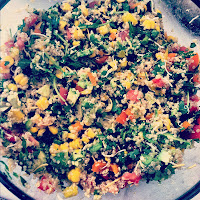Eating healthy doesn't mean you have to give up the foods you love. You just have to make small changes to individual ingredients to keep the taste and make the dish healthier. Here are some common and easy substitutes you can make in your foods:
Cream/Sour Cream/Mayo: Greek Yogurt is a great substitute for all things creamy. I put it in pasta dishes to replace cream sauces, and it works perfectly as sour cream in Mexican dishes etc. By using Greek Yogurt, you reduce fat as well as promote healthy digestion.
Butter: Coconut Oil can be used alone as a spread, or as a replacement in baking for oil and butter. Coconut oil can help with weight loss, and it also, contrary to popular belief, lowers bad cholesterol because it contains lauric acid.
Flour: Almond Meal, which is just ground almonds, is a great way to avoid wheat in baking. You get the benefit of the nuts and avoid the downsides of using processed, white flour.
Chocolate: 70% Dark Chocolate or higher is always the way to go with chocolate. You don't have to give it up, just go darker for more of the health benefits, which include a good source of antioxidants and vitamins, decreased risk of stroke, and more stabilized blood sugar.
Mixed Farro Salad with Truffle Dressing
Ingredients:
Edamame
Dried cranberries
Non-fat feta crumbles
Pistachio nutmeats
Baby broccoli, chopped
For dressing:
Garlic Aoli Mustard
Olive Oil
1. Cook the farro first, let cool.
2. Chop the broccoli into bite-size pieces. Combine the rest of ingredients.
3. To make the dressing, combine the mustard and two types of oil. I had to experiment to get exactly the right consistency and flavor. You don't need a lot of truffle oil because it's very potent, but you might need to add more olive oil to get the dressing to be smooth enough to pour over and toss in the salad.
4. Toss dressing in salad and serve.
Spinach and Artichoke Burgers with Dip
Ingredients:
For burger:
Lean ground turkey meat
Frozen spinach
Dehydrated onions (or chopped fresh)
Garlic powder
Wheat germ (or something equivalent, with the texture of breadcrumbs)
Chopped artichoke hearts OR artichoke bruschetta
Parmesan Cheese
Frozen spinach
Dehydrated onions (or chopped fresh)
Garlic powder
Wheat germ (or something equivalent, with the texture of breadcrumbs)
Chopped artichoke hearts OR artichoke bruschetta
Parmesan Cheese
For Dip/Topping:
Greek yogurt
Garlic powder
Frozen spinach, defrosted
Artichoke
Parmesan Cheese
1. To make the patties, combine all the ingredients until evenly distributed.
2. Heat up a pan with olive oil. Form patties and make sure they aren't too thick so they can cook through. Place in pan.
3. Cover and lower the heat in order to let the patties cook thoroughly. Flip when they turn golden.
4. Make the spinach and artichoke dip topping. Combine ingredients and heat in microwave for about two minutes (be careful not to heat it too long or yogurt will curdle).
5. Top burger with dip, and enjoy!


























.JPG)
























